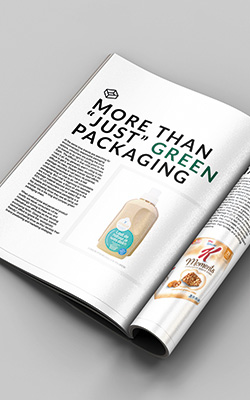 Looking ahead to 2016, Mintel has announced six key trends set to impact global packaging markets over the next year, including implications for both consumers and brands.
Looking ahead to 2016, Mintel has announced six key trends set to impact global packaging markets over the next year, including implications for both consumers and brands.
David Luttenberger, Global Packaging Director at Mintel, said:
“There’s a parallel path between brands striving to engage consumers on a more personal level and consumers’ expectations for packaging to deliver that experience. Digital print that creates ‘hyper’ personal experiences; clean-label messaging that enhances brand transparency and builds purchasing confidence; eco-responsible packaging that empowers social consciousness; next-gen hybrids that offer functional and environmental benefits alongside great shelf presence; right-sized product packaging that meets consumer needs and shifting use-occasions; and apps that support ‘mobile-engaged’ packaging. These are the key themes we see resonating with consumers in 2016.
Brands and manufacturers are innovating packaging to keep global consumers, not only engaged, but to develop brand loyalty which is becoming more and more intangible in this modern age where consumers have more choices than ever before across all packaged goods.”
Digital Evolution
Digital printing is capturing brands’ attention by creating opportunities to engage consumers on a local, personal and even emotional level. With nearly one quarter of Chinese consumers indicating they would pay more for personalised soft drink packaging, digital printing is positioned to grow well beyond industry estimates. In 2016 we will experience the tipping point for digital package printing, as brands move beyond using it for limited editions and personalisation, and capitalise on its economic and speed-to-market advantages for mainstream package decoration.
Show Me The Goods
With the growing number of on-pack claims competing for shoppers’ attention, consumers are demanding more information about what they are really buying but seeking less on-pack clutter that confuses their purchasing decisions. This is perhaps nowhere more apparent than in food, where clear and concise information about ingredients, functional product attributes and safety must be communicated with total transparency. Looking ahead, the concepts of clean labeling and clear on-pack communication are set to converge.
Phenomenal Flexibles
No longer is flexible packaging (specifically pouches) considered a tradeoff. Almost one third (32%) of consumers associate flexible packaging with being modern, and brands are tapping into flexibles’ nearly unparalleled marketing opportunities. But at what point will flexible packaging, especially pouches, become non-differentiated? Truly innovative brands will be looking to the next generation of rigid/flexible hybrids that offer functional and environmental benefits alongside great shelf presence.
More Than “Just” Green Packaging
Despite brands’ best efforts, package recycling is well below its potential. What’s more, 63% of US consumers have stated that reusable and repurposable packaging is a key purchasing driver. Going forward, when product price and perceived product quality are equal, consumers will be increasingly turning to these eco- and alternative-use attributes as the deciding purchasing factor, and brands cannot afford to ignore this as they develop their brand positioning and marketing strategies.
Size Matters
American families are seeking value in larger container sizes for milk; British consumers are asking for more choices in size for alcoholic beverages. What’s more, as evident by the 50% of health-conscious snackers saying they would be willing to try a new product if it comes in a small, trial-size pack, the ability to reach consumers in time-shifting use occasions means brands must offer a greater range of pack sizes. In 2016, brands must deliver packaging that consumers see as right-sized for themselves and shifting use-occasions in order to overcome the growing lack of brand loyalty.
Packaging Mobie-ution
There’s a revolution happening in mobile-engaged packaging. Unlike the previous generation that included clunky QR and text codes, this time around brand owners are tapping near-field communication (NFC) and bluetooth low-energy (BLE) as primary engagement technologies. Moving forward, as brands clamour for innovative ways to engage with shoppers, the mobile environment will become the new front line in the battle to win consumers’ hearts, minds and wallets.

You must be logged in to post a comment Login